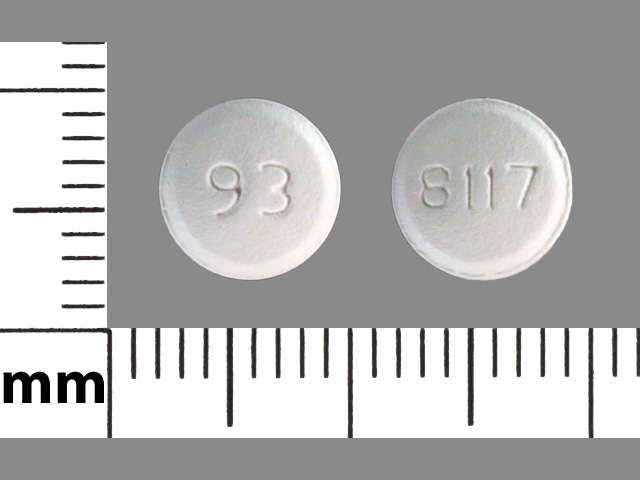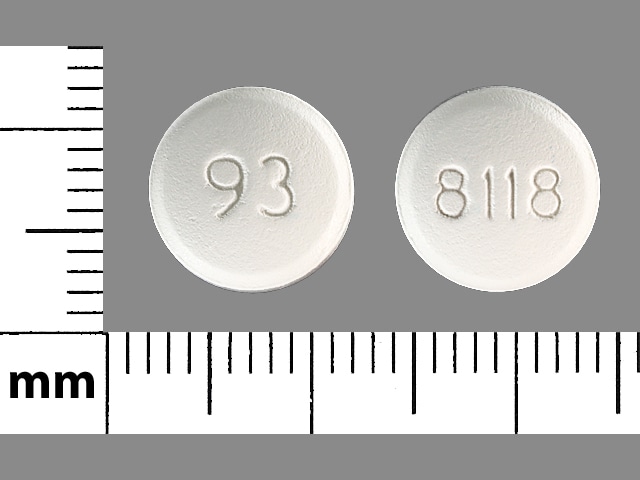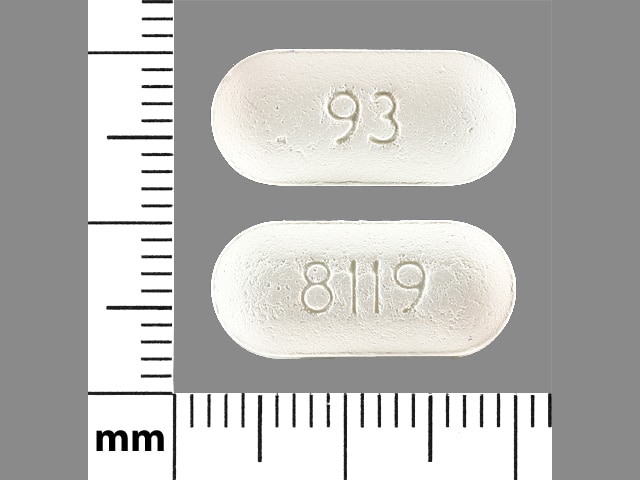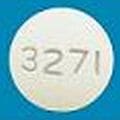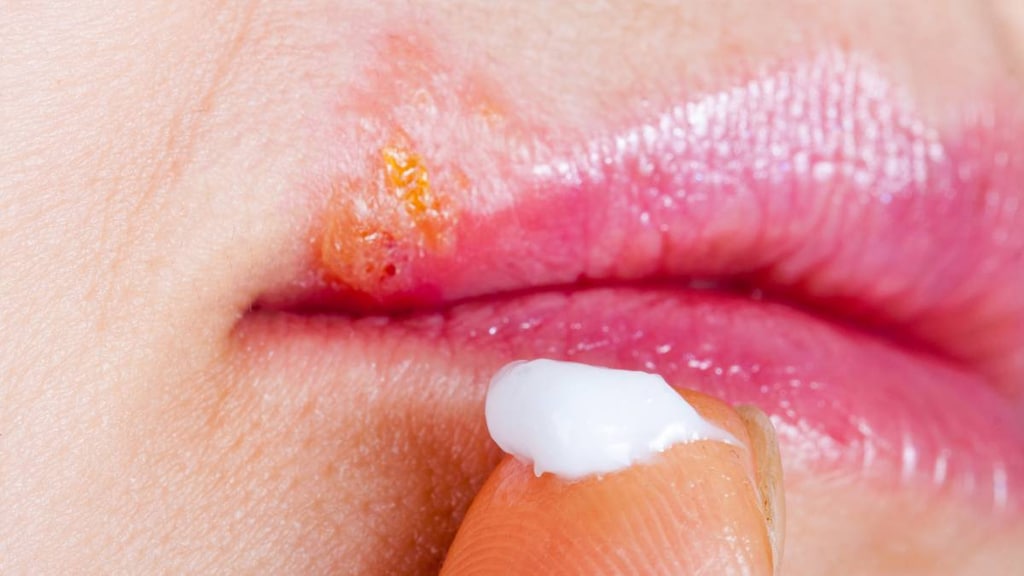Dosage Forms
Excipient information presented when available (limited, particularly for generics); consult specific product labeling. [DSC] = Discontinued product
Tablet, Oral:
Famvir: 125 mg [DSC], 250 mg [DSC], 500 mg [DSC]
Generic: 125 mg, 250 mg, 500 mg
Pharmacology
Mechanism of Action
Famciclovir undergoes rapid biotransformation to the active compound, penciclovir (prodrug), which is phosphorylated by viral thymidine kinase in HSV-1, HSV-2, and VZV-infected cells to a monophosphate form; this is then converted to penciclovir triphosphate and competes with deoxyguanosine triphosphate to inhibit HSV-2 polymerase, therefore, herpes viral DNA synthesis/replication is selectively inhibited.
Pharmacokinetics/Pharmacodynamics
Absorption
Food decreases maximum peak penciclovir concentration and delays time to penciclovir peak; AUC remains the same
Distribution
Vd: Penciclovir: Healthy adults: 1.08 ± 0.17 L/kg
Metabolism
Famciclovir is rapidly deacetylated and oxidized to penciclovir (active prodrug); in vitro data demonstrate that metabolism does not occur via CYP isoenzymes
Excretion
Urine (73% primarily as penciclovir); feces (27%)
Time to Peak
Penciclovir: ~1 hour
Half-Life Elimination
Penciclovir: 2 to 4 hours; Prolonged in renal impairment:
CrCl 40 to 59 mL/minute: ~3.4 hours
CrCl 20 to 39 mL/minute: ~6.2 hours
CrCl <20 mL/minute: ~13.4 hours
Intracellular penciclovir triphosphate: HSV 1: 10 hours; HSV 2: 20 hours; VZV: 7 hours
Protein Binding
Penciclovir: <20%
Use in Specific Populations
Special Populations: Renal Function Impairment
With CrCl 40 to 59 mL/minute, clearance is approximately 13 L/hour; CrCl 20 to 39 mL/minute, clearance is about approximately 4.2 L/hour; CrCl less than 20 mL/minute, clearance is approximately 1.6 L/hour.
Special Populations: Hepatic Function Impairment
Penciclovir Cmax decreased 44% and Tmax increased 0.75 hours in patients with hepatic impairment.
Special Populations: Elderly
Mean penciclovir AUC was 40% higher, and penciclovir renal clearance was 22% lower in elderly volunteers.
Special Populations: Gender
AUC of penciclovir was approximately 9.3 mcg•h/mL and 11.1 mcg•h/mL in male and female volunteers, respectively, after a single 500 mg dose. Penciclovir renal clearance was 28.5 L/h and 21.8 L/h, respectively.
Use: Labeled Indications
Treatment of acute herpes zoster (shingles) in immunocompetent patients; treatment and suppression of recurrent episodes of genital herpes in immunocompetent patients; treatment of herpes labialis (cold sores) in immunocompetent patients; treatment of recurrent orolabial/genital (mucocutaneous) herpes simplex in HIV-infected adult patients
Use: Off Label
Genital herpes simplex virus (HSV) infection (initial episode)yes
Based on the Centers for Disease Control and Prevention (CDC) sexually transmitted diseases treatment guidelines, famciclovir is an effective and recommended agent for the initial episode of genital herpes simplex virus (HSV) in immunocompetent patients.
Herpes simplex virus (HSV) chronic suppressive therapy in HIV-infected patientsyes
Based on the US Department of Health and Human Services (HHS) Guidelines for Prevention and Treatment of Opportunistic Infections in HIV-Infected Adults and Adolescents, famciclovir is effective and recommended as chronic suppressive therapy of HSV infections in adolescent and adult HIV-infected patients.
Herpes zoster (shingles) in HIV-infected patientsyes
Based on the US Department of Health and Human Services (HHS) Guidelines for Prevention and Treatment of Opportunistic Infections in HIV-Infected Adults and Adolescents, famciclovir is an effective and recommended agent in the management of acute localized herpes zoster (shingles) in adolescent and adult HIV-infected patients.
Varicella infection (chickenpox) in HIV-infected patientsyes
Based on the US Department of Health and Human Services (HHS) Guidelines for Prevention and Treatment of Opportunistic Infections in HIV-Infected Adults and Adolescents, famciclovir is an effective and recommended agent in the management of uncomplicated cases of varicella infection (chickenpox) in adolescent and adult HIV-infected patients.
Contraindications
Hypersensitivity to famciclovir, penciclovir, or any component of the formulation
Dosage and Administration
Dosing: Adult
Genital herpes simplex virus (HSV) infection: Oral: Note: Initiate therapy as soon as possible after diagnosis and within 72 hours of rash onset
Immunocompetent patients:
Initial episode (off-label use): 250 mg 3 times daily for 7 to 10 days. Note: Treatment can be extended if healing is incomplete after 10 days of therapy (CDC [Workowski 2015])
Recurrence:
125 mg twice daily for 5 days or 500 mg as a single dose, followed by 250 mg twice daily for 2 days (CDC [Workowski 2015]).
Suppressive therapy: 250 mg twice daily. Note: Duration not established, but efficacy/safety have been demonstrated for 1 year (CDC [Workowski 2015]).
Manufacturer’s labeling: Dosing in the prescribing information may not reflect current clinical practice. 1,000 mg twice daily
HIV-infected patients:
Initial or recurrent episodes: 500 mg twice daily for 5 to 10 days (HHS [OI adult 2016])
Chronic suppressive therapy (off-label use): 500 mg twice daily; suppressive therapy can be continued indefinitely regardless of CD4 count in patients with severe recurrences of genital herpes or in patients who want to minimize frequency of recurrences, or to reduce the risk of genital ulcer disease in patients with CD4 cell counts <250 cells/mm3 who are starting antiretroviral therapy. However, continuation of therapy should be reviewed annually, particularly if immune reconstitution has occurred (HHS [OI adult 2016]).
Manufacturer’s labeling: Dosing in the prescribing information may not reflect current clinical practice. Recurrent episodes: 500 mg twice daily
Herpes labialis/orolabial (cold sores): Oral: Note: Initiate therapy as soon as possible after diagnosis and within 72 hours of rash onset
Immunocompetent patients:
Recurrent episodes: 1,500 mg as a single dose; initiate therapy at first sign or symptom such as tingling, burning, or itching (initiated within 1 hour in clinical studies)
HIV patients:
Treatment: 500 mg twice daily for 5 to 10 days (HHS [OI adult 2016])
Manufacturer’s labeling: Dosing in the prescribing information may not reflect current clinical practice. Recurrent episodes: 500 mg twice daily
Herpes zoster (shingles): Oral: Note: Initiate therapy as soon as possible after diagnosis and within 1 week of rash onset or any time before full crusting of lesions
Immunocompetent patients: 500 mg every 8 hours for 7 days
HIV-infected patients with acute localized dermatomal lesion (off-label use): 500 mg 3 times daily for 7 to 10 days; consider longer duration if lesions heal slowly (HHS [OI adult 2016])
HIV-infected patients with extensive cutaneous lesion or visceral involvement (off-label use): Initial therapy with acyclovir IV may be switched to famciclovir 500 mg 3 times daily to complete a 10 to 14 day course, when formation of new lesions has ceased and signs and symptoms of visceral VZV infection are improving (HHS [OI adult 2016])
Varicella infection (chickenpox) in HIV-infected patients (uncomplicated cases) (off-label use): Oral: 500 mg 3 times daily for 5 to 7 days (HHS [OI adult 2016])
Dosing: Geriatric
Refer to adult dosing.
Dosing: Pediatric
Herpes simplex virus (HSV) genital infection: Limited data available:
Immunocompetent patients:
Initial episode: Children weighing ≥45 kg and Adolescents: Oral: 250 mg 3 times daily for 7 to 10 days (CDC [Workowski 2015]; Redbook [AAP 2015]). Note: Treatment can be extended if healing is incomplete after 10 days of therapy (CDC [Workowski 2015]).
Recurrence: Adolescents: Note: Initiate treatment within 1 day of lesion onset or during the prodrome that precedes some outbreaks (CDC [Workowski 2015]).
One-day regimen: Oral: 1,000 mg twice daily for 1 day
Two-day regimen: Oral: 500 mg once as a single dose, followed 12 hours later by 250 mg twice daily for a total of 2 days
Five-day regimen: Oral: 125 mg twice daily for 5 days
Suppressive therapy: Adolescents: Oral: 250 mg twice daily. Note: Duration not established; efficacy/safety have been demonstrated for 1 year (CDC [Workowski 2015]).
HIV-exposed/-positive patients:
Initial or recurrent episodes: Adolescents: Oral: 500 mg twice daily for 5 to 10 days (HHS [OI adult 2016]). Note: Treatment can be extended if healing is incomplete after 10 days of therapy (CDC [Workowski 2015]).
Chronic suppressive therapy: Adolescents: Oral: 500 mg twice daily; suppressive therapy can be continued indefinitely regardless of CD4 count in patients with severe recurrences of genital herpes or in patients who want to minimize frequency of recurrences, or to reduce the risk of genital ulcer disease in patients with CD4 cell counts <250 cells/mm3 who are starting antiretroviral therapy. However, continuation of therapy should be reviewed annually, particularly if immune reconstitution has occurred (HHS [OI adult 2016]).
Herpes labialis/orolabial (cold sores) in HIV-exposed/-positive patients, treatment: Limited data available: Adolescents: Oral: 500 mg twice daily for 5 to 10 days (HHS [OI adult 2016])
Herpes zoster (shingles) in HIV- exposed/-positive patients, treatment (HHS [OI adult 2016]): Limited data available: Adolescents: Oral:
Acute localized dermatomal lesion: 500 mg 3 times daily for 7 to 10 days; consider longer duration if lesions heal slowly
Extensive cutaneous lesion or visceral involvement: Initial therapy with acyclovir IV may be switched to famciclovir 500 mg 3 times daily to complete a 10- to 14-day course, when formation of new lesions has ceased and signs and symptoms of visceral VZV infection are improving
Varicella infection (chickenpox) in HIV-exposed/-positive patients (uncomplicated cases), treatment: Limited data available: Adolescents: Oral: 500 mg 3 times daily for 5 to 7 days (HHS [OI adult 2016])
Administration
Oral: May be administered without regard to meals.
Storage
Store at 20°C to 25°C (68°F to 77°F); excursions permitted to 15°C to 30°C (59°F to 86°F).
Famciclovir Images
Drug Interactions
Cladribine: Agents that Undergo Intracellular Phosphorylation may diminish the therapeutic effect of Cladribine. Avoid combination
Talimogene Laherparepvec: Antiherpetic Antivirals may diminish the therapeutic effect of Talimogene Laherparepvec. Monitor therapy
Varicella Virus Vaccine: Famciclovir may diminish the therapeutic effect of Varicella Virus Vaccine. Management: When possible, avoid use of famciclovir within the 24 hours prior to administration of the varicella vaccine, and avoid use of famciclovir for 14 days after vaccination. Avoid combination
Zoster Vaccine (Live/Attenuated): Famciclovir may diminish the therapeutic effect of Zoster Vaccine (Live/Attenuated). Management: When possible, discontinue antiviral agents with anti-zoster activity (i.e., acyclovir, valacyclovir, famciclovir) for at least 24 hours prior to and 14 days after receiving a live attenuated zoster vaccine. Avoid combination
Adverse Reactions
Frequencies vary with dose and duration.
>10%:
Central nervous system: Headache (9% to 23%)
Gastrointestinal: Nausea (11% to 13%)
1% to 10%:
Central nervous system: Fatigue (≤5%), migraine (≤3%), paresthesia (≤3%)
Dermatologic: Pruritus (2% to 4%), skin rash (3%)
Gastrointestinal: Diarrhea (2% to 8%), flatulence (≤5%), vomiting (≤5%)
Genitourinary: Dysmenorrhea (≤8%)
Hematologic & oncologic: Neutropenia (3%), leukopenia (1%)
Hepatic: Increased serum ALT (3%), increased serum AST (2%), increased serum bilirubin (2%)
<1%, postmarketing, and/or case reports: Abnormal hepatic function tests, anaphylactic shock, anaphylaxis, anemia, angioedema (eyelid edema, facial edema, periorbital edema, pharyngeal edema), cholestatic jaundice, confusion, delirium, disorientation, dizziness, drowsiness, erythema multiforme, hallucination, hypersensitivity angiitis, palpitations, seizure, Stevens-Johnson syndrome, thrombocytopenia, toxic epidermal necrolysis, urticaria
Warnings/Precautions
Disease-related concerns:
- Renal impairment: Use with caution in patients with renal impairment; dosage adjustment required. Acute renal failure has been reported with use of inappropriate high doses in patients with underlying renal disease.
Dosage form specific issues:
- Lactose: Tablets contain lactose; do not use with galactose intolerance, severe lactase deficiency, or glucose-galactose malabsorption syndromes.
Other warnings/precautions:
- Appropriate use: Has not been established for use in initial episodes of genital herpes, recurrent episodes of genital herpes in Black and African-American patients, patients with ophthalmic or disseminated zoster, immunocompromised patients (except HIV-infected patients with orolabial or genital herpes).
Monitoring Parameters
Periodic CBC during long-term therapy; renal function
Pregnancy
Pregnancy Considerations
Based on available data, use during pregnancy appears to be well tolerated; however, other agents are preferred when treatment is needed (CDC [Workowski 2015]; Werner 2017).
Health care providers are encouraged to enroll women exposed to famciclovir during pregnancy in the Famvir Pregnancy reporting system (888-669-6682).
Patient Education
What is this drug used for?
- It is used to treat or prevent herpes infections.
- It is used to treat cold sores.
- It is used to treat shingles.
- It may be given to you for other reasons. Talk with the doctor.
Frequently reported side effects of this drug
- Headache
- Nausea
- Abdominal pain
- Menstrual pain
- Diarrhea
Other side effects of this drug: Talk with your doctor right away if you have any of these signs of:
- Signs of a significant reaction like wheezing; chest tightness; fever; itching; bad cough; blue skin color; seizures; or swelling of face, lips, tongue, or throat.
Note: This is not a comprehensive list of all side effects. Talk to your doctor if you have questions.
Consumer Information Use and Disclaimer: This information should not be used to decide whether or not to take this medicine or any other medicine. Only the healthcare provider has the knowledge and training to decide which medicines are right for a specific patient. This information does not endorse any medicine as safe, effective, or approved for treating any patient or health condition. This is only a brief summary of general information about this medicine. It does NOT include all information about the possible uses, directions, warnings, precautions, interactions, adverse effects, or risks that may apply to this medicine. This information is not specific medical advice and does not replace information you receive from the healthcare provider. You must talk with the healthcare provider for complete information about the risks and benefits of using this medicine.
